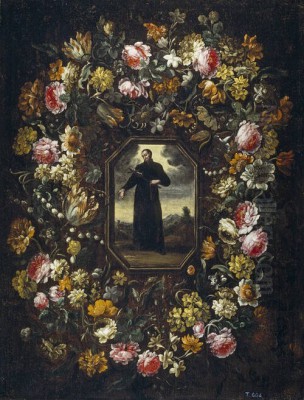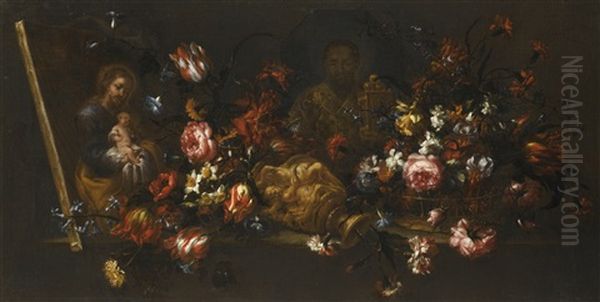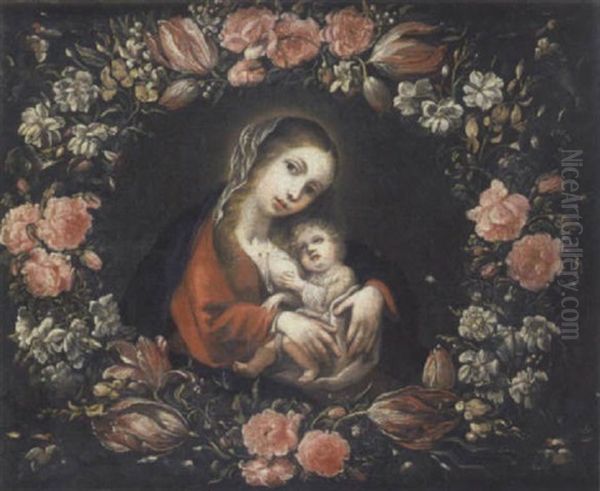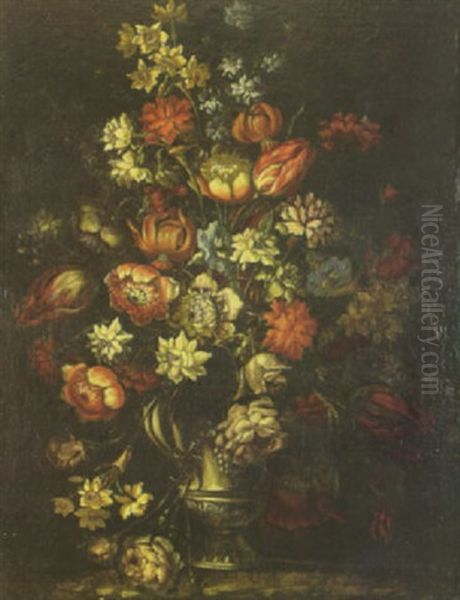
The Spanish Golden Age, spanning roughly the late 16th to the late 17th century, witnessed an extraordinary flourishing of arts and literature. Within this vibrant cultural landscape, painting reached remarkable heights, particularly in Madrid, the heart of the Spanish monarchy. While figures like Diego Velázquez dominated court portraiture and religious narrative, a specialized genre, flower painting, also achieved exquisite refinement. Among its most accomplished practitioners was Bartolomé Pérez de la Dehesa (1634-1693), an artist whose delicate brushwork and harmonious compositions secured his place as a leading master of the Madrid school in the latter half of the 17th century.
Early Life and Artistic Formation in Madrid
Bartolomé Pérez was born in Madrid in 1634, entering a world where artistic activity was deeply intertwined with the patronage of the Church and the Crown. The city was a magnet for artists, fostering a competitive yet collaborative environment. Crucial to Pérez's development was his apprenticeship under Juan de Arellano (1614-1676), who was arguably the most celebrated Spanish flower painter of the period. Arellano's workshop was a significant center for this specialization, known for its vibrant and decorative floral arrangements.
Pérez proved to be an adept student, quickly mastering the techniques and stylistic conventions favored by his teacher. His connection to Arellano deepened beyond the professional realm; Pérez married Juana de Arellano, his master's daughter, further integrating himself into this prominent artistic family. This familial tie likely provided him with stability and continued access to the networks and clientele established by his father-in-law. He absorbed Arellano's penchant for rich color and dynamic compositions, but soon began to develop his own distinct artistic personality.
The Flourishing Art of Flower Painting

Bartolomé Pérez's reputation rests primarily on his exceptional skill as a flower painter. He excelled in various formats within the genre, including traditional bouquets in vases, elaborate garlands, and decorative floral borders. His approach combined meticulous observation of nature with a characteristically Baroque sense of movement and opulence. Unlike the starker realism sometimes found in earlier Spanish still life (bodegón) painters like Francisco de Zurbarán or Juan Sánchez Cotán, Pérez embraced a more decorative and visually sumptuous style, reflecting the tastes of his era.
His works often feature a profusion of blooms, rendered with remarkable detail and botanical accuracy. Tulips, roses, carnations, irises, and lilies spill from ornate vases or weave through intricate garlands. Pérez demonstrated a masterful control of light and shadow, modeling the delicate petals and leaves to give them a convincing sense of volume and texture. His palette was typically bright and harmonious, employing rich reds, pinks, blues, and yellows, often set against dark, neutral backgrounds that made the flowers stand out dramatically.
A representative example of his skill is Flowers in a Glass Vase. In works like this, Pérez not only captures the beauty and fragility of the individual flowers but also creates a balanced and dynamic overall composition. The transparency of the glass vase is often rendered with particular skill, showcasing his technical virtuosity. Another notable work, Bouquet on a Gilt Ground, held in the Spanish Royal Collection, exemplifies the luxurious quality sought by elite patrons. The gilded background adds a layer of richness and formality, elevating the floral arrangement to an object of precious beauty.
Influences and Stylistic Development
While deeply rooted in the Madrid school established by Arellano, Pérez's style also reveals an awareness of broader European trends. The influence of Flemish flower painting, particularly the tradition associated with artists like Daniel Seghers (1590-1661) and Jan Brueghel the Elder (1568-1625), is evident. Seghers, a Jesuit painter from Antwerp, popularized the format of devotional images surrounded by meticulously painted flower garlands, a compositional device Pérez also employed effectively. The Flemish emphasis on detailed realism and vibrant color certainly resonated with Pérez's own inclinations.
Italian painting may also have played a role, perhaps indirectly through prints or the presence of Italian works in Spanish collections. The Baroque dynamism and theatricality found in some Italian art could have informed Pérez's more elaborate compositions. However, he adapted these influences into a distinctly Spanish idiom, characterized by a certain gravity and intensity, even within the decorative context of flower painting.

Compared to his master, Juan de Arellano, Pérez is often considered to have achieved a greater subtlety and refinement in his brushwork and color harmonies. While Arellano's works can be bolder and more robust, Pérez's paintings often possess a more delicate and atmospheric quality. Some art historians suggest that Pérez eventually surpassed his teacher in technical finesse and compositional elegance, though both remain central figures in the history of Spanish still life.
Religious Subjects and Decorative Schemes
Beyond his specialization in still life, Bartolomé Pérez was also a capable painter of religious subjects and contributed to larger decorative projects. This versatility was common among successful artists of the period, who needed to adapt their skills to various types of commissions. His religious works often incorporated his expertise in floral painting, seamlessly blending figurative scenes with decorative botanical elements.
Works such as the Assumption of the Virgin demonstrate his ability to handle narrative subjects within a decorative framework, likely intended as part of a larger altarpiece or decorative scheme. In paintings like Vase of Flowers with Saint Francis of Assisi or Saint Christopher with the Christ Child (dated 1683-84), Pérez integrates religious figures within or alongside his signature floral arrangements. These works showcase a sophisticated compositional sense, balancing the figurative elements with the intricate detail of the flowers. The inclusion of figures associated with Juan de Solís (Arellano's own teacher) in the Saint Christopher suggests a continuity of workshop traditions.
Other religious titles attributed to him include Our Lady of Good Counsel (c. 1680), depicting a venerated statue within a church setting adorned with flowers, Saint Joseph with the Child, and Saint Roch. These paintings reveal his understanding of Catholic iconography and his ability to convey religious sentiment, albeit often filtered through his primary lens as a master of floral decoration. His skill in composition and movement, noted in works like the Saint Francis piece, was applicable across genres.
Theatrical Design and Royal Recognition
Pérez's talents extended to the ephemeral world of theatrical design. He is documented as having designed scenery for performances at the Buen Retiro Palace theatre in Madrid. This royal palace complex was a major center for courtly entertainment, featuring elaborate stage productions that required skilled artists to create convincing backdrops and settings. This work would have demanded creativity, speed, and an understanding of perspective and illusionistic effects, complementing his skills as an easel painter. His involvement suggests connections with other artists engaged in similar large-scale decorative projects, such as Francisco Rizi (1614-1685) and later, Claudio Coello (1642-1693).

His growing reputation and connections eventually led to the highest form of official recognition. In 1689, during the reign of Charles II, Bartolomé Pérez was appointed Pintor del Rey (Painter to the King). This prestigious title placed him in the esteemed lineage of court painters that included the legendary Diego Velázquez (1599-1660) and his successor Juan Carreño de Miranda (1614-1685). While perhaps not tasked with the grand portraits expected of his predecessors, this appointment acknowledged his mastery and secured his services for the Crown, likely involving decorative commissions for royal residences and potentially continuing his work for the theatre.
Context within the Madrid School and Contemporaries
Bartolomé Pérez operated within the vibrant artistic milieu of late 17th-century Madrid. The legacy of the High Baroque, shaped by Velázquez, Alonso Cano (1601-1667), and Francisco de Herrera the Younger (1627-1685), still lingered. However, the dominant figures during Pérez's mature career were painters like Carreño de Miranda and Francisco Rizi, who adapted the grandeur of the earlier generation to the changing tastes of the court of Charles II.
Pérez's specialization placed him in a slightly different category, but he was undoubtedly part of this artistic community. His collaborations, particularly within the Arellano workshop, demonstrate the interconnectedness of Madrid artists. He would have been aware of the works of other prominent painters active in the capital, such as Mateo Cerezo (1637-1666), known for his dynamic religious scenes and still lifes, and later Claudio Coello, who became the leading court painter towards the end of the century, famous for his monumental work The Sacred Host in the Escorial.
While direct documented interactions with giants like Velázquez (who died when Pérez was 26) or the Naples-based Spaniard Jusepe de Ribera (1591-1652) are lacking, Pérez's art exists within the broader context they defined. His work, like that of many contemporaries, reflects the prevailing Baroque aesthetics: emotional intensity (even in the implied transience of flowers), dramatic lighting, rich color, and complex compositions. His specific contribution was to elevate flower painting to a level of technical brilliance and decorative sophistication that rivaled the best practitioners across Europe, including Flemish masters like Jan Philips van Thielen (1618-1667).
Later Life, Tragic End, and Lasting Legacy
Despite achieving royal recognition, Pérez's later years seem to have been marked by difficulties. Sources suggest he faced financial troubles, a common plight for artists even at the highest levels, dependent as they were on often-unreliable patronage. His life came to a sudden and tragic end in 1693. While working on scaffolding, likely engaged in a decorative painting project, he suffered a fall and died from his injuries. This unfortunate accident cut short the career of one of Madrid's most refined artistic talents.

Bartolomé Pérez's legacy lies in his significant contribution to the genre of Spanish flower painting. He built upon the foundation laid by his father-in-law, Juan de Arellano, developing a style characterized by greater delicacy, refined color sense, and intricate detail. His works represent the culmination of this specialized tradition within the Madrid school of the late Baroque. He demonstrated that still life, particularly the depiction of flowers, could achieve a level of artistry and sophistication comparable to historical or religious painting.
His paintings were sought after by collectors during his lifetime and continue to be admired today. Major museums, including the Prado Museum in Madrid, hold significant examples of his work, allowing contemporary audiences to appreciate his technical skill and the elegant beauty of his floral compositions. While sometimes overshadowed by the towering figures of the Spanish Golden Age, Bartolomé Pérez remains a crucial figure for understanding the diversity and richness of Baroque art in Spain, particularly the exquisite development of flower painting as a high art form. His ability to infuse decorative arrangements with vitality and grace ensures his enduring appeal.
Conclusion: An Enduring Bloom in Spanish Art
Bartolomé Pérez de la Dehesa stands as a testament to the depth and specialization within the Spanish Baroque. As a master of flower painting, he captured the ephemeral beauty of nature with unparalleled technical skill and aesthetic refinement. Trained by and eventually rivaling his renowned father-in-law, Juan de Arellano, Pérez carved out his own distinct style, marked by delicate brushwork, harmonious color, and elegant compositions. His appointment as Painter to the King confirmed his status within the competitive Madrid art world. Though his life ended prematurely, his exquisite paintings of flowers, garlands, and religiously themed floral arrangements continue to enchant viewers, securing his position as one of the most important Spanish still life painters of the 17th century. His work remains a vibrant and enduring bloom in the rich garden of Spanish art history.